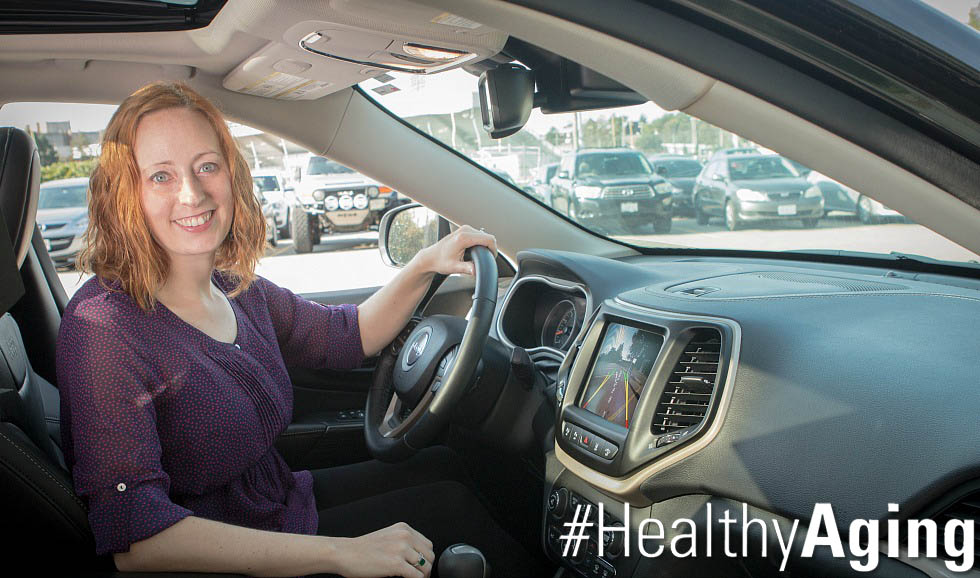Seniors see high-tech cars as both friend and foe, study says

A new study led by McMaster researcher Jessica Gish (pictured) found that seniors are embracing Advanced Vehicle Technologies (AVTs) like back-up cameras and blind spot monitors, but are using them selectively.
BY Erica Balch
September 27, 2016
When the seniors in a recent McMaster study on high tech cars first started driving, car safety was a comparatively low-tech affair. Forget innovations like ABS and airbags– back in the 1960s and 70s, seatbelt use wasn’t even mandatory in most jurisdictions.
Fast-forward 40 years and there’s been an explosion of new technologies meant to make driving both safer and easier than ever before. From back-up cameras to forward collision warnings, Advanced Vehicle Technologies (AVTs) are increasingly showing up in cars at all price points.
So what are seniors making of all these new features? It turns out that, far from being technophobes; older adults are embracing these technologies, but with a few caveats.
“They think of them as both friend and foe,” says Jessica Gish, a researcher in McMaster’s Department of Health Aging and Society and lead author of the study. “They talk about all the things they love about AVTs and they recognize the value in these technologies, but they aren’t entirely comfortable with them either.”
The study, funded by the Labarge Optimal Aging Initiative and through a grant from the Social Sciences and Humanities Research Council (SSHRC), took place over six months and involved interviews with a group of 35 older adults with vehicles equipped with at least two AVT features such as lane departure warning systems, blind spot monitors, back-up cameras and GPS systems to examine seniors’ perceptions and use of these technologies.
“Older adults have a longer driving history with different types of automobiles, but haven’t learned to drive in a high tech car,” says Gish. “I was interested in how this technology is changing the experience of driving for older adults and what opportunities or anxieties it’s presenting.”
She says the seniors in her study learned how to use these features without difficulty– in many cases reporting that the technology made them feel safer, but says they also used them selectively.
For example, while participants said they felt comfortable– and often preferred– to use back-up cameras to help them park in areas with lots of other cars and pedestrians, they also turned off other features, like adaptive cruise control– a system that automatically adjusts vehicle speed to maintain a safe distance from cars ahead– reporting that they sometimes felt uncomfortable relying on the technology to do the work of driving for them.
“They‘re developing a critical relationship with AVTs,” she says. “For example, they might do a shoulder check rather than relying solely on the car’s blind spot monitor. They tend to think through whether they’re going to use their own skills, the technology or a combination of both.”
Gish says this reaction to the technology is in contrast to research on young adults that looked at the use of GPS (Global Positioning System). According to research, young adults were willing to rely heavily on the technology, but were also likely to panic if their GPS failed. Gish says the seniors in her study saw driving as a shared responsibility between driver and technology, recognizing that drivers are expected to be “in control” of driving.
“They are carrying with them their driving experiences with the low-tech car and may have a healthier relationship with the automobile than younger drivers. It also raises the question, can younger drivers learn from older drivers?”
Even so, Gish says seniors repeatedly expressed the concern that they too may one day become dependent on AVTs. “They’re lamenting the potential loss of their driving skills,” she says. “They recognize that these technologies might make them lazy.”
And if you think seniors are looking at AVTs as a way to stay on the road for longer, Gish says, think again.
“I asked them, ‘do you think these technologies could extend your driving life?’ Many of them said they hoped not. There was this potential concern that AVTs might make it a bit more difficult to walk away from driving. When the time comes, most of them want to be able to say, ‘enough is enough.’”
Gish plans to continue her research and says she hopes to conduct a longitudinal study to see whether the driving behaviour of these seniors changes over time.
“Because these technologies are new, they have this hyper-awareness and are really reflecting and thinking about what they’re doing,” she says. “I’m interested in what happens once they get used to the technology. Will they loose this criticality and become dependant? We may see that these technologies create new and troublesome driving habits.”


